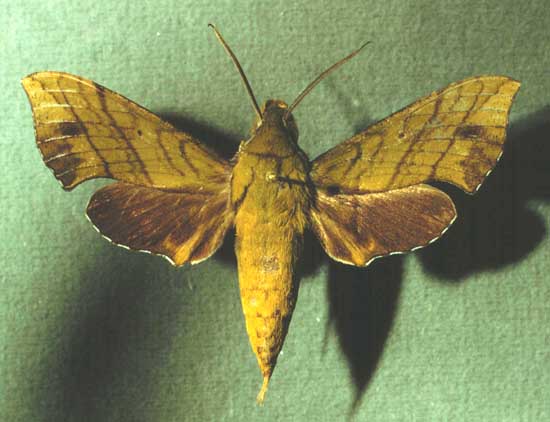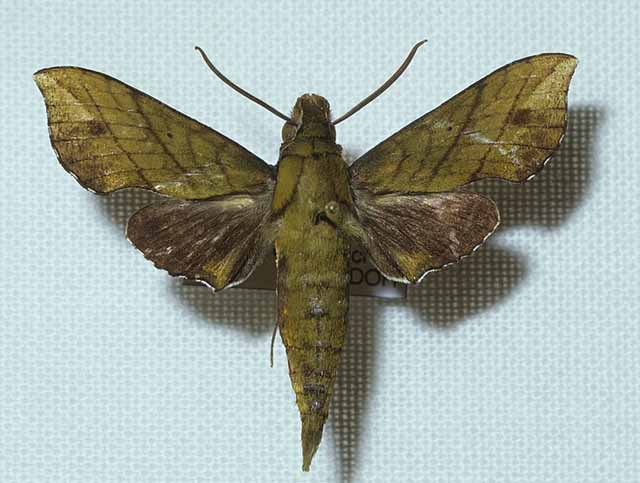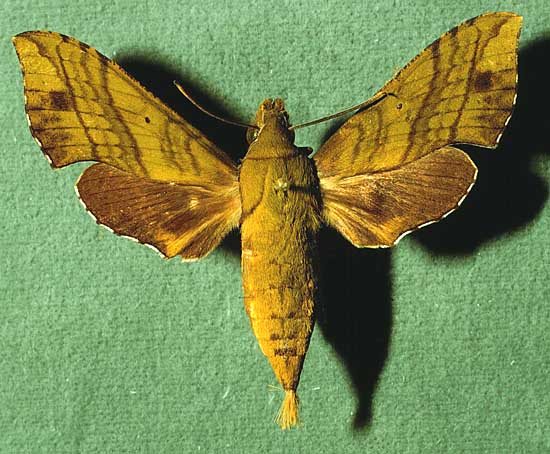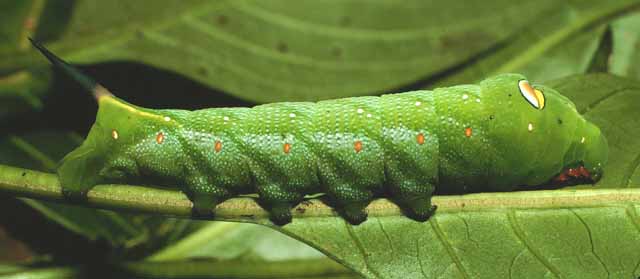Xylophanes adalia
Xylophanes adalia
zail-AH-fan-eesmm
a-DAL-ee-uh or
zye-LAH-fan-eesmm
a-DAL-ee-uh
(Druce, 1881) Calliomma

Xylophanes adalia male courtesy of Dan Janzen.
This site has been created by
Bill Oehlke at oehlkew@islandtelecom.com
Comments, suggestions and/or additional information are welcomed by Bill.
TAXONOMY:
Family: Sphingidae, Latreille, 1802
Subfamily: Macroglossinae, Harris, 1839
Tribe: Macroglossini, Harris, 1839
Genus: Xylophanes Hubner [1819] ...........
Species: adalia Druce, 1881
|
MIDI MUSIC
.....It's a Wonderful World.....
copyright C. Odenkirk
ON.OFF
<bgsound src="world.mid" LOOP=FOREVER>
|
DISTRIBUTION:
Xylophanes adalia moths
[wingspan 55-56 mm, females larger than males]
fly in Panama (specimen type locality) and Costa Rica and north to
southeastern Belize and Mexico.
Hubert Mayer indicates they fly as far south as
Ecuador.
"Similar to Xylophanes depuiseti and Xylophanes ploetzi.
Forewing apex less extended than in Xylophanes depuiseti; distal margin not distinctly sinuous between M3 and 1A+2A.
Underside of body and wings more golden-yellow (yellowish green in Xylophanes depuiseti and Xylophanes ploetzi).
Lines on forewing upperside more distinct than in Xylophanes depuiseti, especially the oblique apical line; a roughly square,
black patch present between M2 and M3, distal to outermost postmedian line; fringe white spotted to apex, not restricted to posterior
part of wing as in Xylophanes depuiseti and Xylophanes ploetzi." CATE

Xylophanes adalia male, La Union del Toachi, Ecuador,
January, courtesy of Hubert Mayer
copyright.
FLIGHT TIMES:
Xylophanes adalia adults fly in
January in Ecuador and may have a much more extensive flight season
there and elsewhere.
ECLOSION:
Pupae probably wiggle to surface from subterranean chambers just prior to eclosion.

Xylophanes adalia female courtesy of Dan Janzen.
SCENTING AND MATING:Females call in the males with a pheromone released from a gland at the tip of the
abdomen. Males come in to lights very readily, but females are seldom taken in that way.
EGGS, LARVAE, PUPAE:
Larvae probably feed on Psychotria panamensis and Psychotria nervosa
of the Rubiaceae family and on
Pavonia guanacastensisof the Malvaceae family.
Moths emerge approximately one-two months after larvae pupate.


Images courtesy of Dan Janzen.
The pronunciation of scientific names is
troublesome for many. The "suggestion" at the top of the page is
merely a suggestion. It is based on commonly
accepted English pronunciation of Greek names and/or some
fairly well accepted "rules" for latinized scientific names.
The suggested pronunciations, on this page and on other pages,
are primarily put forward to assist those who hear with internal
ears as they read.
There are many collectors from different countries whose
intonations and accents would be different.
Jean Marie Cadiou writes, "When I say "Xylophanes" in English I
pronounce it something like "Zailophanees", with the emphasis on the
"o". The French pronounce it differently, something like
"Kzeelophaness" with no emphasis, and the Germans yet in a
different way..."
In Greek myth, Phanes is the golden winged Primordial Being who
was hatched from the shining Cosmic Egg that was the source of the
universe. He personifies light emerging from chaos.
"Xylo" is the Greek word for wood.
The specimen type for the genus
Xylophanes is Xylophanes anubus. Perhaps ? when Hubner
examined that species, the yellow-orange and brown tones of the
forewings suggested wings of wood.
In the Bible, Adalia is one of Haman's sons.
The word means noble one. It is also a Hebrew name, meaning
"God is my refuge". I believe it is also the name of a city in
Ancient Greece.
Use your browser "Back" button to return to the previous page.
Goto Main Sphingidae Index
Goto Macroglossini Tribe
Goto Central American Indices
Goto Carribean Islands
Goto South American Indices
Goto U.S.A. tables




